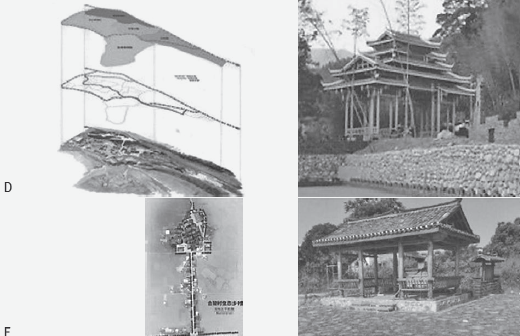Semiotic Analysis of Chinese Folk Architecture in Modern Planning
DOI:
https://doi.org/10.31522/p.32.2(68).7Keywords:
architectural planning, architecture semiotics, Chinese folk architecture, national history of ChinaAbstract
The study aims to explore the semiotics of the genetic symbols of Chinese folk architecture as the basis for representing the symbolic and mythological events of national history in the contemporary reconstruction of traditional settlements. The questionnaire-based survey, which involved 227 city dwellers and 239 residents of traditional villages, was used to assess architectural objects. As a result, the study justified the use of Chinese folk architecture symbols when implementing the Chinese state program for the traditional village revival, as well as when solving the problems of preserving the original historical architectural heritage in Western Chinatowns and in China itself. The mentioned symbols can be used to determine the conceptual approaches in architectural planning of traditional Chinese rural settlements.
References
Aroni, G. (2023) ‘Semiotics in architecture and spatial design’. In: D. Cobley, P.J. Schulz, M. Cavallaro, K. Kull, G. Aroni, A. Ponzio, and J. Deely (eds), Bloomsbury Semiotics Volume 2: Semiotics in the Natural and Technical Sciences. London: Bloomsbury, pp. 277-278. https://doi.org/10.5040/9781350139350.ch-12
Asadpour, A. (2020) ‘Defining the concepts and approaches in vernacular architecture studies’, Nature: National Academic Journal of Architecture, 7(2), pp. 241-255. https://doi.org/10.24252/nature.v7i2a8
Barthes, R. (1997) ‘Semiology and the urban’. In: N. Leach (ed), Rethinking architecture: a reader in cultural theory. London: Psychology Press, pp. 158-173.
Bian, J.; Chen, W., and Zeng, J. (2022) ‘Spatial distribution characteristics and influencing factors of traditional villages in China’, International Journal of Environmental Research and Public Health, 19(8), p. 4627. https://doi.org/10.3390/ijerph19084627
Chang, Q. (2019) ‘Architectural models and their contexts in China’s 20th-century architectural heritage: An overview’, Built Heritage, 3, pp. 1-13. https://doi.org/10.1186/BF03545715
China Discovery (n.a.) Guilin Map 2023: Updated, Detailed and Downloadable. Available at: https://www.chinadiscovery.com/guilintours/maps.html [Accessed: 29 September 2023].
Chu, Y. (2020) ‘Hypoiconicity in the architecture of Suzhou: Authentic resemblance, diagrammatic reduction, and metaphoric displacement’, Social Semiotics, 30(1), pp. 114-132. https://doi.org/10.1080/10350330.2018.1531548
Cultural Keys (2023) Five Things to Know About… Horse Head Walls! Available at: https://www.culturalkeys.cn/2023/01/03/fivethings-horse-head-walls/ [Accessed: 9 June 2024]
Dai, Y. (2022) ‘Application of regional culture in landscape architecture design under the background of data fusion’, Scientific Programming, 2022, pp. 1-12. https://doi.org/10.1155/2022/6240313
Denison, E. (2018) ‘Modern heritage, the other, and the anthropocene’, Built Heritage, 2(4), pp. 31-41. https://doi.org/10.1186/BF03545682
Ding, J. (2020) ‘Research on peony cultural landscape: A semiotic perspective’, Solid State Technology, 63(2), pp. 2699 -2709.
Eco, U. (1997) ‘Function and sign: The semiotics of architecture’. In: N. Leach (ed), Rethinking architecture: A reader in cultural theory. London: Psychology Press, pp. 173- 196.
Eskandani, O.H.; Aluclu, İ., and Dorai, P. (2022) ‘A research on the reading of architectural buildings with semiotic design setup’ (Jewish Museum Example by Daniel Libeskind)’, Journal of Positive School Psychology, 6(9), pp. 2513-2525.
Fachun, C., and Leontovich, O.A. (2020) ‘A tale of two cities: historical narratives in the Russian and Chinese urban landscapes’, Vestnik Volgogradskogo Gosudarstvennogo Universiteta. Seriya 2, Yazykoznanie, 19(2), pp. 78-85. https://doi.org/10.15688/jvolsu2.2020.2.7
Fengshui (n.a.) The Lo shu Magic Square Part 3. Available at: https://www.fengshui.net/loshu/the-lo-shu-magic-square-part-3-5062/ [Accessed: 29 September 2023]
Gamerwall (n.a.) Dragons Qin Dynasty China. Available at: https://gamerwall.pro/33786-drakony-dinastija-cin-kitaj.html [Accessed: 29 September 2023]
González Martínez, P. (2021) ‘Echo from the underground: The heritage customization of subway infrastructures in Shanghai’s listed areas’, Built Heritage, 5(1), p. 5. https://doi.org/10.1186/s43238-021-00024-y
Han, K.T. (2023). ‘Empirical and quantitative studies of Feng Shui: A systematic review’ (PRISMA 2009 item 1)’, Heliyon, 9, p. e19532. https://doi.org/10.1016/j.heliyon.2023.e19532
Hassan, M.M.; Ahmad, N., and Hashim, A.H. (2021) ‘Homebuyers superstitious belief: Feng shui and housing property’, International Journal of Academic Research in Business and Social Sciences, 11(7), pp. 444-462. https://doi.org/10.6007/IJARBSS/v11-i7/10297
He, G. (2021) ‘Symbol and communication: Study on the relationship between exhibition activities and city image and its application’. In: 2020 International Conference on Language, Communication and Culture Studies (ICLCCS 2020). London: Atlantis Press, pp. 159-162. https://doi.org/10.2991/assehr.k.210313.029
Hu, B.; Zelenko, O.; Pinxit, V., and Buys, L. (2019) ‘A social semiotic approach and a visual analysis approach for Chinese traditional visual language: A Case of tea packaging design’, Theory and Practice in Language Studies, 9(2), pp. 168-177. https://doi.org/10.17507/tpls.0902.06
Hu, Z.; Strobl, J.; Min, Q.; Tan, M., and Chen, F. (2021) ‘Visualizing the cultural landscape gene of traditional settlements in China: A semiotic perspective’, Heritage Science, 9(1), p. 115. https://doi.org/10.1186/s40494-021-00589-y
Huang, Y.; Li, E., and Xiao, D. (2022) ‘Conservation key points and management strategies of historic villages: 10 cases in the Guangzhou and Foshan Area, Guangdong Province, China’, Journal of Asian Architecture and Building Engineering, 21(4), pp. 1320-1331. https://doi.org/10.1080/13467581.2021.1941979
Johnson, S. (2021) ‘National and intergenerational similarities and differences in stated preferences’. In: Caught in the Cultural Preference Net: Three Generations of Employment Choices in Six Capitalist Democracies. Oxford: Oxford University Press, pp. 157-173. https://doi.org/10.1093/oso/9780190672782.003.0007
Knapp, R.G.; Miller, T.E., and Liu, J. (2020) ‘China’s corridor bridges: Heritage buildings over water’, Built Heritage, 4, p. 10. https://doi.org/10.1186/s43238-020-00010-w
Koh, J.H., and Lim, C.M. (2022) ‘Architectural language of the Southern Fujianese traditional Chinese temple timber frame structure in West Malaysia: A cultural semiotics analysis’, Archnet- IJAR: International Journal of Architectural Research, 17(1), pp. 24-42. https://doi.org/10.1108/ARCH-12-2021-0351
Kryžanowski, Š. (2021) ‘Feng shui: A comprehensive review of its effectiveness based on evaluation studies’, International Journal of Advances in Scientific Research and Engineering, 7, pp. 61-71. https://doi.org/10.31695/IJASRE.2021.34103
Leach, N. (2017) ‘Belonging: towards a theory of identification with space’. In: E. Rooksby (ed), Habitus: A sense of place. London: Routledge, pp. 313-328.
Lee, J.W., and Lou, J.J. (2019) ‘The ordinary semiotic landscape of an unordinary place: Spatiotemporal disjunctures in Incheon’s Chinatown’, International Journal of Multilingualism, 16(2), pp. 187-203. https://doi.org/10.1080/14790718.2019.1575837
Li, P.Q., and Kovacs, J.F. (2022) ‘Creative tourism and creative spaces in China’, Leisure Studies, 41(2), pp. 180-197. https://doi.org/10.1080/02614367.2021.1948596
Liu, Q.; Liao, Z.; Wu, Y.; Degefu, D.M., and Zhang, Y. (2019) ‘Cultural sustainability and vitality of chinese vernacular architecture: A pedigree for the spatial art of traditional villages in Jiangnan region’, Sustainability, 11(24), p. 6898. https://doi.org/10.3390/su11246898
Mei, Q. (2017) ‘Constructing new meanings of Chinese architectural heritage in the world heritage sites of Malacca Straits’, Built Heritage, 1(1), pp. 26-35. https://doi.org/10.1186/BF03545667
Saidi, U. (2019) ‘Heritage, semiotics and innovations: Architectural space, object-designs, meanings and implications in sustainable development’, Social Semiotics, 29(4), pp. 448-462. https://doi.org/10.1080/10350330.2018.1443584
Shao, Y., and Zhang, L. (2018) ‘The historical value and contemporary role of vernacular wisdom: The case of Zengchong Village’, Built Heritage, 2, pp. 123-140. https://doi.org/10.1186/BF03545714
Tian, F. (2021) ‘A study of taishan Shigandang culture in English literary records’, Advances in Literary Study, 9(4), pp. 189-196. https://doi.org/10.4236/als.2021.94020
Wang, M. (2020) ‘The historical mission of Chinese semiotics’. In: Linguistic Semiotics. Cham: Springer, pp. 365-372. https://doi.org/10.1007/978-981-15-3246-7_17
Wang, S. (2017) ‘Urban conservation through Chinese local original architecture: The preservation and renovation of Zhongshan road in Hangzhou’, Built Heritage, 1(1), pp. 50-56. https://doi.org/10.1186/BF03545669
Wang, Y., and Feng, D. (2023) ‘History, modernity, and city branding in China: A multimodal critical discourse analysis of Xi’an’s promotional videos on social media’, Social Semiotics, 33(2), pp. 402-425. https://doi.org/10.1080/10350330.2020.1870405
Wei, H.; Yu, Y., and Yuan, Z. (2022) ‘Heritage tourism and nation-building: Politics of the production of Chinese national identity at the mausoleum of yellow emperor’, Sustainability, 14(14), p. 8798. https://doi.org/10.3390/su14148798
Wu, H.; Techasan, S., and Huebner, T. (2020) ‘A new Chinatown? Authenticity and conflicting discourses on Pracha Rat Bamphen Road’, Journal of Multilingual and Multicultural Development, 41(9), pp. 794-812. https://doi.org/10.1080/01434632.2020.1746318
Xue, K. (2022) Applied research on spatial narrative in rural architectural design. Available at: https://pea.lib.pte.hu/bitstream/handle/pea/34287/kang-xue-tezis-eng-2022.pdf?sequence=2andisAllowed=y [Accessed: 29 September 2023]
Yongting, S. (2022) Research on the conservation and renewal of rural landscape and vernacular architecture in Chongqing, China. DLA Dissertation, University of Pecs.
Zeng, J., and Wang, M. (2021) ‘The narrative function of temporal signs: Toward a semionarratology approach’, Chinese Semiotic Studies, 17(3), pp. 371-385. https://doi.org/10.1515/css-2021-2003
Zhang, L.; Pei, T.; Wang, X.; Wu, M.; Song, C.; Guo, S., and Chen, Y. (2020) ‘Quantifying the urban visual perception of Chinese traditionalstyle building with street view images’, Applied Sciences, 10(17), p. 5963. https://doi.org/10.3390/app10175963
Zhang, T.; Hu, Q.; Ding, Q.; Zhou, D.; Gao, W., and Fukuda, H. (2021) ‘Towards a rural revitalization strategy for the courtyard layout of vernacular dwellings based on regional adaptability and outdoor thermal performance in the gully regions of the Loess Plateau, China’, Sustainability, 13(23), p. 13074. https://doi.org/10.3390/su132313074
Zhou, M.; Chu, S., and Du, X. (2019) ‘Safeguarding traditional villages in China: The role and challenges of rural heritage preservation’, Built Heritage, 3, pp. 81-93. https://doi.org/10.1186/BF03545729
Zhou, Y., and Wei, M. (2021) ‘Sinicisation and ethnicity: Spatial characteristics of shui vernacular architecture in Guizhou, Southwest China’, Built Heritage, 5(1), p. 2. https://doi.org/10.1186/s43238-021-00021-1
Zou, H.; Ge, J.; Liu, R., and He, L. (2023) ‘Feature recognition of regional architecture forms based on machine learning: a case study of architecture heritage in Hubei Province, China’, Sustainability, 15(4), p. 3504. https://doi.org/10.3390/su15043504
Zwerger, K. (2019) ‘Vernacular architecture: A term denoting and transporting diverse content’, Built Heritage, 3(4), pp. 14-25. https://doi.org/10.1186/BF03545716

Downloads
Published
How to Cite
Issue
Section
License
Copyright (c) 2024 Min Li , Xian Hu

This work is licensed under a Creative Commons Attribution 4.0 International License.
Copyright (c) 2021 authors and journal.
This work is licensed under a Creative Commons Attribution 4.0 International License.
Authors who publish with this journal agree to the following terms:
In agreeing this form, you certify that:
- You read the ethical codex of the PROSTOR available at journal web.
- You submitted work is your original work, and has not previously been published and does not include any form of plagiarism.
- You own copyright in the submitted work, and are therefore permitted to assign the licence to publish to PROSTOR.
- Your submitted work contains no violation of any existing copyright or other third party right or any material of an obscene, libellous or otherwise unlawful nature.
- You have obtained permission for and acknowledged the source of any illustrations, diagrams or other material included in the work of which you are not the copyright owner.
- You have taken due care to ensure the accuracy of the work, and that, to the best of your knowledge, there are no false statements made within it.
- All co-authors of this submitted work are aware of, and in agreement with, the terms of this licence and that the submitted manuscript has been approved by these authors.






